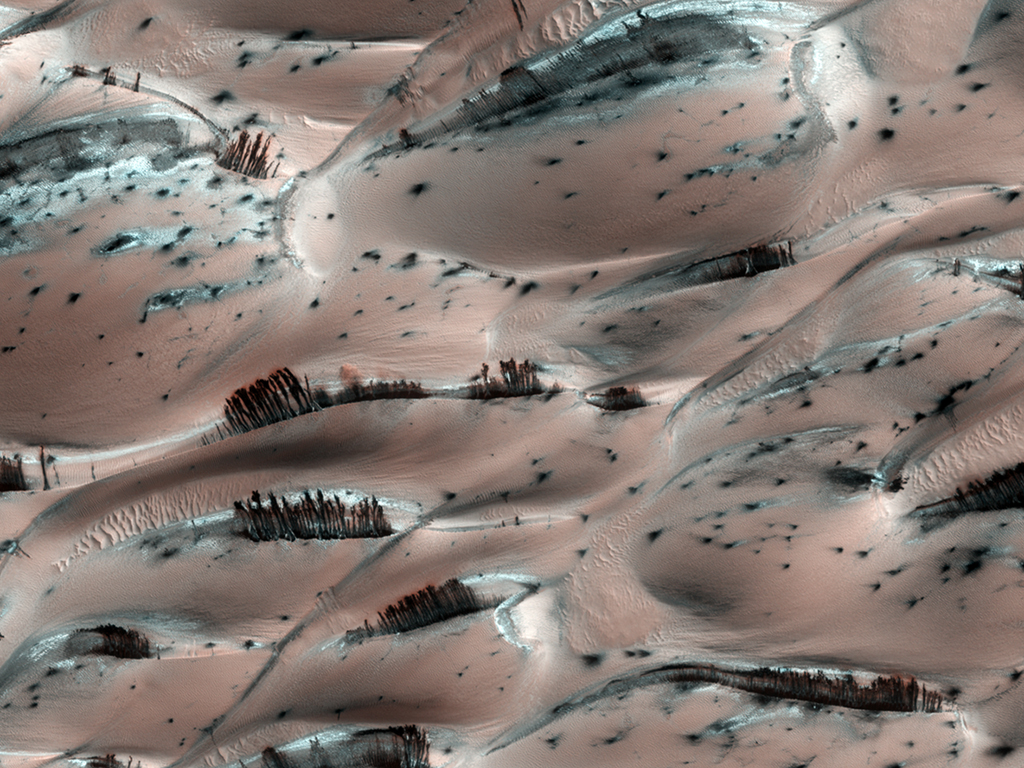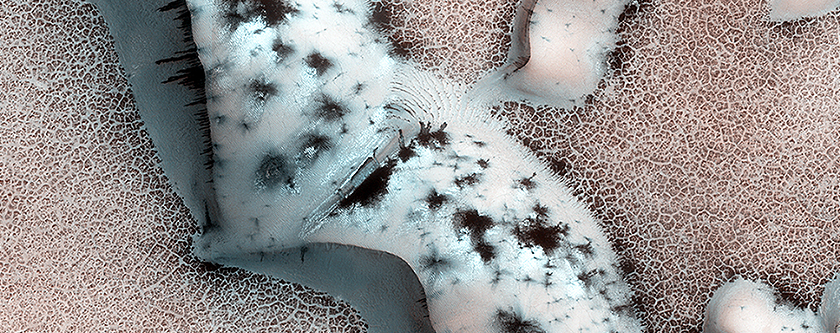
After posting on my google+ sci-fi community about the forests on Mars, several interesting comments and opinions surfaced. I polled the community and asked: What do you think the ghost forests are?
Two-hundred and thirty-two avid sci-fiers voted and provided the following results.
- Evidence of Life 11%
- Darker cascading sands 23%
- Frozen carbon dioxide 34%
- Spider-like channels around gas leaks 9%
- Something else 24%

Photo credit: NASA/JPL/University of Arizona
A NASA employee provided additional links to the forest images. According to the information offered in these additional links, the 34% are right.
The bright spots are carbon dioxide frost. On Mars, the main atmospheric component is carbon dioxide, which circulates seasonally between the atmosphere and the polar regions. One of the reasons that permit this process is the fact that temperatures on Mars are much colder than on Earth, which allows carbon dioxide frost to condense on the surface in winter.
When spring comes however, the surface heats up and the carbon dioxide frost eventually sublimates (turns directly from the solid to the vapor state), and forms jets of carbon dioxide mixed with dust, leading to the formation of the dark features we see in the image.
Such processes occur seasonally on Mars, and therefore are continuously being monitored by the HiRISE scientists to assess the differences from one year to the next.
Written by: M. Ramy El-Maarry (22 January 2014)
I surfed the net and the NASA website for information on the forest of Mars, but apparently I wasn’t searching in the right spots.
ProbeFiling
If you click on any of the above links, you will notice the key work in the search is HiRISE, which stands for High Resolution Imaging Science Experiment. HiRise is also the name of the camera onboard the Mars Reconnaissance Orbiter and according to NASA it is the most powerful one of its kind ever sent to another planet. Its high resolution allows us to see Mars like never before, and helps other missions choose a safe spot to land for future exploration.
Now what I don’t get is the “ua” in front of http/ “hirise.org”. How are we supposed to locate such a viable source of information without having the help of a NASA employee? I probably could have figured out “hirise” eventually, but “ua”— never.
I asked the NASA employee:
ME: “Do you have to be a rock scientist to be privy to such information?”
NASA: “You just have to know where to look amongst the maze of NASA websites.”
Wait! Maze of NASA websites…!??
You mean there is more than one?
QUESTION: And why is there more than one?
NEXT: And why is it so bloody hard to find?
I smell conspiracy theory. Maybe.
The Probe’s Mission Statement

The Probe is a blog devoted to the exploration of the unexplainable, to finding the truth in occurrences that resemble science fiction, and to researching and reporting on topics that could be flung upon the wall of weird. New posts are featured every week.
( Mostly on Mondays, but sometimes I release early, like on Sundays, if I have a writing deadline, or if I’m going camping, or if I have something exciting I just can’t wait to tell you. BUT sometimes, I’m late. Like this week. Sorry. Space aliens abducted my computer and refused to return it until I acknowledged their existence. So here goes: Yes. I believe.)
Sign up to get my weekly, slightly irregular blog posts delivered directly to your email. No spam. Promise.
blog post #110
- Urban Legend in the Making - April 22, 2024
- Coghlan’s Traveling Coffin Urban Legend - April 4, 2024
- Richmond Vampire Urban Legend - March 7, 2024
